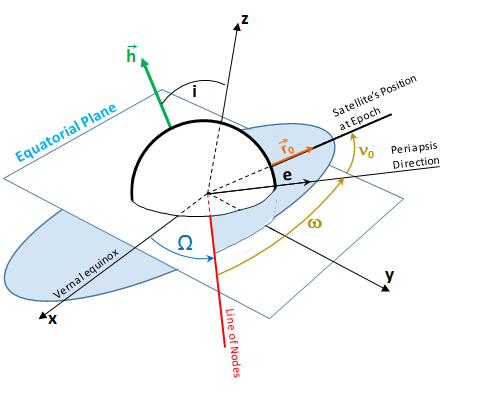Non-spherical Earth Perturbation - RAAN
`dotOmega_"J2" = -1.5 * "n" *J_2 (R_E/ "a" )^2 * (cos( "i" )) / (1- "e" ^2)^2`
Tags | |
UUID | aa7aa8ee-ed25-11e3-b7aa-bc764e2038f2 |
This equation computes the rate of change of the right ascension of the ascending node (RAAN) of an orbit where the rate of change (`dotOmega_"J2"`) in deg/day results from the `J_2` geopotential coefficients derived from the geopotential function of the Earth. The inputs to this equation are:
- the mean motion of the orbit (n) in deg/day
- the Earth equatorial radius (`R_E`) in kilometers
- the orbit's semi-major axis (a) in kilometers
- the eccentricity of the orbit, (e)
- the orbit inclination (i)

Notes
The earth is not a sphere. In fact, the Earth is neither a homogeneous mass nor a sphere. Consequently, the several attributes of the Earth's shape and composition have noticeable affects on a satellite's orbit. The bulge at the equator, the flattening at the poles, and the slight pear shape of the Earth are important contributors to the perturbation of an orbit due to a non-spherical Earth.
This equation, Non-spherical Earth Perturbation - RAAN, references 1 page
Equations and Data Items
This equation, Non-spherical Earth Perturbation - RAAN, is used in 1 page
Calculators
- Comments
- Attachments
- Stats
No comments |
This site uses cookies to give you the best, most relevant experience. By continuing to browse the site you are agreeing to our use of cookies.
